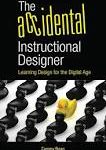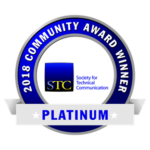By Marcia Shannon
Cammy Bean. 2014. ASTD Press, Arlington, Virginia. [ISBN-13:978-1-56286-914-4, e-ISBN: 978-1-60728-407-9. 202 pages, including resources, bibliography, and index. US$32.95 (softcover).
Cammy Bean has written a twelve-part survey course of instructional design in one entertaining, informative, energizing book. She uses a breezy, good-humored conversational style, making this information-heavy book easier to manage. Do not expect to read this in one sitting. If you like to highlight relevant bits, every page will be day-glo’d in minutes. I took two weeks to read the book, taking time to process what I read.
This is a tour of instructional design and learning theories and their applications. The pages are thick with memorable quotes, tips about the learning and design processes, and insights into the instructional design community. The information value is high, but the text is readable, enjoyable.
The Introduction is the story of how Cammy wandered into instructional design. Having landed there, she decided to become an intentional instructional designer by researching and learning about ID. Noting that her journey was not unique, this book is her way to help other accidental instructional designers who struggle to figure out what to do next.
Part I defines instructional design. It introduces the e-learning pie (learning, creativity, technology, and business). The author discusses what design is in general and why does design matter. Part I starts the reader thinking about the ID experience, laying the groundwork for Part II.
Part II addresses the e-learning design process. Its ten chapters illustrate what works when constructing an e-course. Cammy weaves the theories and methods of learning and instruction into examples, test cases, anecdotes, making the information understandable and applicable to our own work.
Part III is a single chapter, Taking It Forward. Cammy encourages the reader to “Let this book be a gateway—a first step on your journey from an accidental instructional designer to an intentional one.” An elegant way to close the book, with advice and encouragement to the reader to find the path that fits the best.
The title prompted me to read this book. I am an accidental technical writer and occasional instructional designer myself, so I was eager to learn about someone else’s journey. My curiosity was satisfied. I felt energized to continue researching ID and finding opportunities to work in instructional design. I recommend you read this book.
Marcia Shannon, CPTC-Foundation, is an STC Senior Member, Carolina Chapter member, Secretary for the Instructional Design and eLearning and Membership Manager, Technical Editing SIGs, member of the Women in Technical Communication SIG. Her 30+ years of business experience cover IT, consumer goods, mortgage banking, and health insurance. She has written procedures, trained users, and provided user support in each field. Currently, she is on sabbatical, preparing for new adventures in writing.



